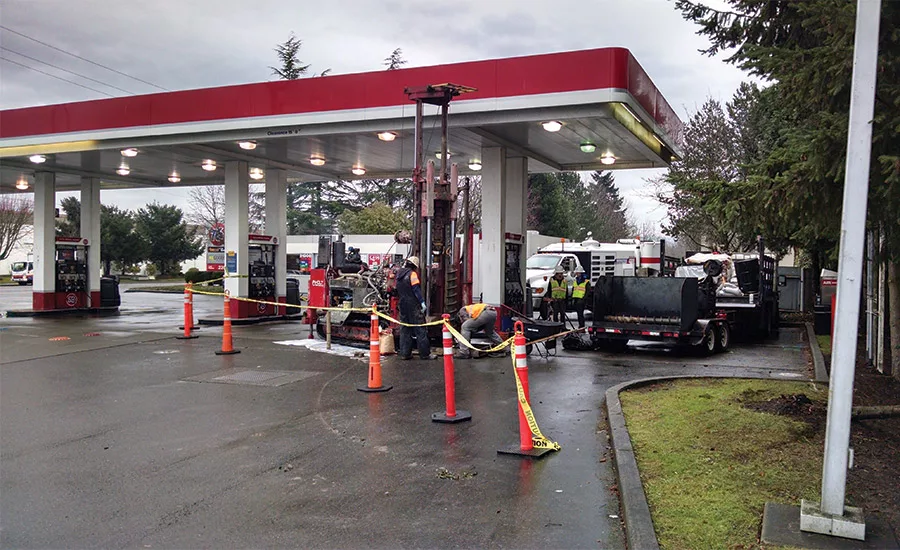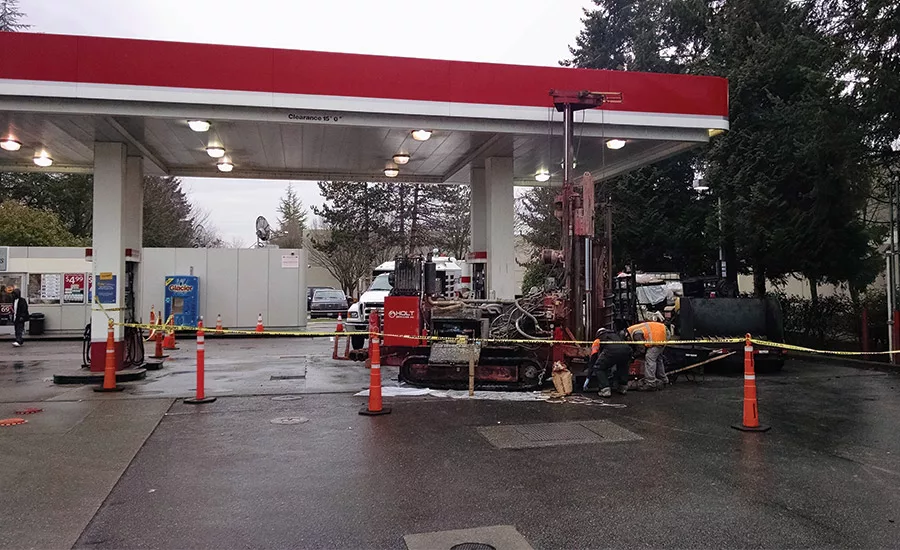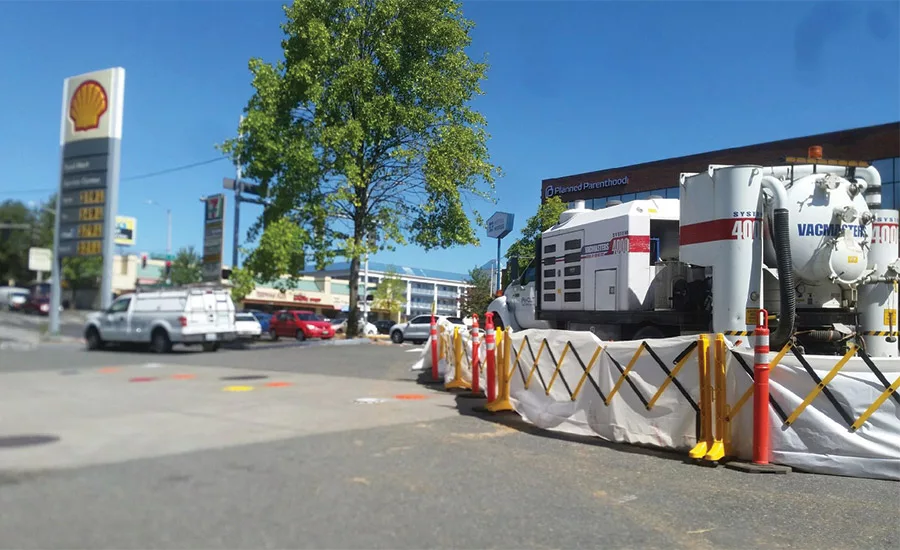What to Expect When Drilling at an Active Gas Station

The potential hazards associated with drilling as a busy gas station challenge even the most experienced environmental drillers.
Source: Holt Services Inc. photos

When creating an exclusion zone for work, candlestick delineators are much easier to see — particularly for motorists — than regular traffic cones.

Pay attention to material underneath the asphalt or concrete. It’s always a good idea to vac clear until you run into native material
Gas stations have been around since the early 1900s and have been an integral part of United States growth and success. But as they assisted in the growth of our country, they also left behind harmful contamination with lasting consequences. For decades, environmental drilling companies have drilled into and investigated the sources of that impact, and installed wells to monitor and remediate it from the soil and groundwater. These drilling projects, although plentiful, can be the most challenging — both technically and logistically.
Over the past 15 years, I’ve had the opportunity to work on meaningful environmental investigation and remediation drilling projects at gas stations around the country. Working at these sites can give drillers solid reassurances about their career, knowing that they’ve done something to help improve the environment. But it can also leave you scratching your head, wondering why you got yourself there in the first place.
Gas stations have evolved significantly from simply being a place to fill up to a place to eat, get your car washed, pick-up groceries and get your car fixed. With the evolution of the gas station came new hazards for those working at them. You will find just about anything at a gas station from people driving away with the fuel pumps stuck in their car to vehicles crashing into each other. At the jobsite, contractors could stumble upon spent needles or see pedestrians hit by cars. They could see fires, people passed out in their cars or construction equipment crashing into canopies. When I think about drilling at a gas station, the first thing that comes to mind is Murphy’s law: Anything that can go wrong, will go wrong.
Article Index:
Beware the Customer
Take a minute and think of the last time you visited a gas station for fuel. Were you in a hurry? Have you — or have you seen someone — run into a person while pulling in or out for a fill up? What about a driver leaving the station with something on top of their car? Have you seen someone pull off with the gas cap open, or with the pump still in the car? There is a reason why we often call gas stations “quick stops.” They are designed for people to get in and out of quickly.
As a contractor, you should never trust that a gas station customer driving your way sees you. You may think they can, but remember: They are coming in for one of a few different reasons, and you were not part of that equation.
Think of how a customer reacts when he drives into the station and notices you have portions of the site blocked off or a dispenser closed. Usually the first instinct is to look around the station to find a place to park or another, open, fuel dispenser. They seek the path of least resistance. As a driller, if you don’t make it clear and leave room for vehicles to get around you, gas station customers are going to encroach into your exclusion zone. Is this impossible to do? Close down the station before work begins or schedule the project at night or when traffic is slow at the site. Don’t put yourself in harm’s way. It’s not worth it.
Follow these tips to maximize safety on a busy gas station jobsite:
- Use 48-inch candlestick delineators when setting up an exclusion zone. In the forecourt of a gas station, these ensure vehicles can see the work area.
- Avoid the use of regular traffic cones. Vehicles cannot see them while backing up or when in close proximity.
- Use caution tape — or fencing is an even better option — to keep the general public and unauthorized personnel from entering your work zone. I can’t tell you how many times I have seen someone break through or walk past and underneath my caution tape. They don’t think of themselves getting hit or falling into a pit. All they think about is getting to where they want.
- If you need to work near or in a driveway entrance or exit, close the entire entrance or exit off. If it is not feasible to close the entrance off, use a vehicle as a buffer and don’t leave your back to traffic. The use of traffic signs also helps. The more advanced notice you can give drivers, the better chances they will see the closed entrance/exit.
- If you need to work near or in an open driveway entrance or exit, use a designated spotter who can help direct vehicles around the closure.
- If you are working in the forecourt of a gas station, take note of the traffic flow onsite. As you think about equipment placement, you don’t want to corner vehicles or send vehicles toward each other.
The bottom line when it comes to gas station customers? Prior planning is important. In planning your jobsite, avoid situations that would frustrate you as a driver. You don’t want to make motorists angry, due to the potential for acting up or road rage. As you think about jobsite layout, pay particular attention to where vehicles might back up. Avoid setting up or parking behind parking spots or other areas where cars back up. Most vehicles and onsite equipment have blind spots and are not equipped with backup cameras.
Avoid Distractions
Gas station sites are plagued with distractions. Cars move in and out to get fuel. People walk in and out of the station. Don’t forget about deliveries, nearby sidewalks and roads, homeless people, drug deals, broken down vehicles, and tow trucks. The list goes on and on.
The scenario I see most is people stepping away from the work zone to pick up a phone call, or to get materials or tooling from a truck. They immediately step away, pick up the phone and start walking aimlessly, disregarding oncoming traffic, vehicles backing up, etc. Most stations have dedicated walkways. If they don’t, I suggest to crews that they walk along the perimeter of the site and avoid walking through fuel dispensing areas. We’ve all seen videos of people walking into things while talking on cellphones.
Don’t add to the madness by not paying attention to your surroundings. It’s easy to become focused and lost in work on site, but always remember the old football term: “Keep your head on a swivel.” Things are constantly changing around you, and you need to see the hazard before it becomes an incident. It’s never a good idea to use a phone in or just outside an exclusion zone. If you need to talk on your phone, step off site or in an area free of vehicle traffic. I call it “anchoring.” Anchor yourself to an outside building or something away from the work area, and don’t walk around. Stay put.
Do Not Disturb
It’s always best to keep the owner and manager of the gas station happy. They can make life way more difficult by denying access, restricting work hours and, even worse, complaining to your client. They know you have a job to do, but so do they.
It’s not uncommon for gas stations to have multiple deliveries each day. It is a best practice to get confirmation of deliveries prior to starting work. If you are doing work within a delivery area, try to work around the delivery schedule. You are going to piss off the station owner if you slow down their business and affect deliveries. If drilling in a particular location will affect deliveries, plan that portion of the work either before or after any expected deliveries. If possible, request that deliveries get postponed until work has been completed. Keep in mind that many sites only have one access point for fuel deliveries, and some companies have a strict no-backing policy for fuel truck drivers.
If a fuel delivery is expected you should stop work until the delivery has been completed. This is due to the potential hazards associated with a release, fire, explosion, runaway truck or harmful gas vapors. It also minimizes business interference.
Recognizing Hazards
Understand the importance of stop work authority. It is everyone’s responsibility to stop work if they see something unsafe or hazardous. This applies not only to your work crew, but to everyone coming into the gas station. I like to use the phrase, “you see it, you own it.” What if you saw someone doing something unsafe and they got hurt or even killed? Would you feel guilty about not saying something? To that end, here are some best practices to head off hazards:
- Create an exclusion zone that is well delineated and as much as possible out of the main traffic areas.
- Think and plan ahead. Hold your tailgate meeting away from the site, perhaps on a sidewalk adjacent to the site. Observe the traffic patterns. Be aware of the access and egress points to the site. Be cautious of access points from busy or high-speed roads. Vehicles will likely be coming into the station hot.
- Look up and pay attention to towering up canopy and overhead hazards. Before going to the site, obtain a site map and do a Google Earth search. Often, you can find out a station’s canopy height using Street View. Another way to find out? Call the station or do a site visit and measure if it’s not listed on the canopy.
- Be aware of underground utilities. Gas stations have a lot of them. From sewer, power, water and gas coming into the station building, to UST vent lines and product dispenser piping, gas stations teem with underground hazards. Often, public One Call notifications are insufficient and do not cover utilities that run into private property. I recommend a few things. Get a private utility locator to complete electromagnetic scans, GPR and geophysical surveys. Obtain an as-built from the station owner to determine where the utilities on site run. Last but not least, pre-clear the location using an air-knife vacuum truck. This is the only sure way to ensure there are no utilities within your boring location.
- On the topic of utilities, look for pavement scarring or patch marks. Look for manholes, storm drains and other oddities at the ground surface. It’s best to avoid these areas altogether. Rule of thumb is to step out your drill location by 5 feet.
- Minimize use of a pry bar or jackhammer when completing hole clearance activities below ground. Utilities can be cased in clay and PVC so when you throw a rock bar down there you can easily cause damage.
- Pay attention to the material under the asphalt or pavement. Is it pea-gravel fill or debris? It’s always a good idea to vac clear until you run into native material. Keep in mind that fill can extend more than 10 feet in some cases.
Check out the latest in environmental monitoring
From distracted motorists to unforeseen utilities, gas station work can prove challenging to even the most experienced environmental drillers. Following these tips from years of successful site investigations can give drillers more days satisfied they made a difference, instead of scratching their heads wondering about their career choices.
Looking for a reprint of this article?
From high-res PDFs to custom plaques, order your copy today!



